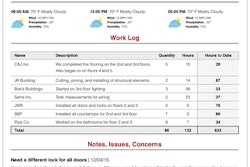
Article originally appeared on thelienzone.com
By Patrick Barthet
A contractor’s daily reports are critical. In many instances, they are considered key evidence showing what actually occurred at specific times on the job. And since people’s memories fade, those trying to get the truth will likely rely heavily on what the daily reports say happened (especially when presented with a corroborating witness).
The problem is that many contractors fail to create these reports. And those that do create them do it only at the beginning of the project or sporadically throughout the progress of the job — generally only when they are reminded to do so. Daily reports (hence the name) only become truly effective when they are, in fact, done daily.
The importance of timely documentation
The reason that daily reports are admissible in court (again, with corroborating testimony) is that they are interpreted as being recorded at or about the time the events in question occurred. Field managers should, therefore, write up these reports daily while the work is occurring or very soon thereafter to capture as accurate an account as possible. Not created until the end of the week or month, the information will surely not be as accurate and may not be as helpful in supporting a particular position.
What to include in daily construction reports
To reduce a construction company’s exposures, daily reports should clearly describe the entire project’s status as it applies to a contractor’s scope and the project’s schedule. At a minimum, the report should include the following eight items:
- The date of the report.
- The author of the report.
- The time work started and finished on that day.
- A description of the weather.
- On smaller jobs, a list of the employees and subcontractors, by name, title and company, who are on the jobsite. On medium to large jobs, the total number of employees and subcontractors by title and company will suffice.
- Any material deliveries of significance, especially large dollar items; for example, fixtures or pallets of tile.
- The current state of the schedule as compared to planned scope of work and what is causing any delay.
- Anything else that is out of the ordinary that may be occurring, or not occurring, that is impacting or may impact the project or the contractor’s schedule and work.
Photographing the work
Contractors can also supplement their daily reports with photographs. Case in point — a stucco contractor received a delay claim from the general contractor asserting that he hadn’t completed his work on time. Fortunately, the stucco contractor had his construction records in the form of pictures which showed post tension cables sticking out of the building.
With those in hand, he explained to the general contractor that he was prevented from putting swing stages down the building, something essential for him to apply the stucco. A handful of photos saved him from having to deal with a legal headache.
Photos can weigh heavily on those seeking what actually happened on a given project. Having photographs that depict the situation make it much easier to prove a position. So when taking photos for your construction records, do at least these two things:
- Include a description noting when and where the picture was taken. Having thousands of pictures on a job downloaded from Dropbox with no way to tell when or where they were taken is no help. Photos need to show a visual history of the job to be useful. Identify all pictures with a date and time stamp and a note indicating where they were taken.
- Save and back up all photos. Anyone assigned to take photos on the job can easily use a cell phone to take pictures. But those visuals won’t do any good if the person’s phone is lost or damaged. Save all pictures in a central location and back everything up, regularly.
Especially on large jobs, but still applicable to smaller projects, contractors can also videotape their work and add that to their construction records by walking the site and narrating where they are and what they are looking at. If needed, go back and take screenshots of the video and note the time, date and location based on the narration.
Recording activity through daily reports and supplementing those with photographs can make the difference between winning and losing, so do it and do it well.
This article was also previously published on ClockShark
Additional resources for daily reporting
Daily reports no longer have to be time consuming manual tasks. There are many mobile apps available to make construction daily reporting easier, faster and easily referenced.
Here are a few options we've highlighted on ForConstructionPros.com:
[APP] Field Tracking and Daily Reporting Made Easy with CrewTracks Mobile App
[APP] Construction Daily Reports App Automates Daily Reporting Tasks
[APP] Create Construction Daily Reports on Your Mobile Device in Minutes
[APP] Create Professional Reports from the Jobsite with #1 Rated Raken Daily Reporting Mobile App
[APP] Get Real-time Production Data from the Field with Rhumbix Mobile App
[APP] Construction Manager App Keeps Info Flowing Smoothly from Field to Office
[APP] Manage Construction Project Life Cycles with BuildginBlok
[APP] Track Hours, Employees, Equipment and Materials with NoteVault Crew! Mobile App

















